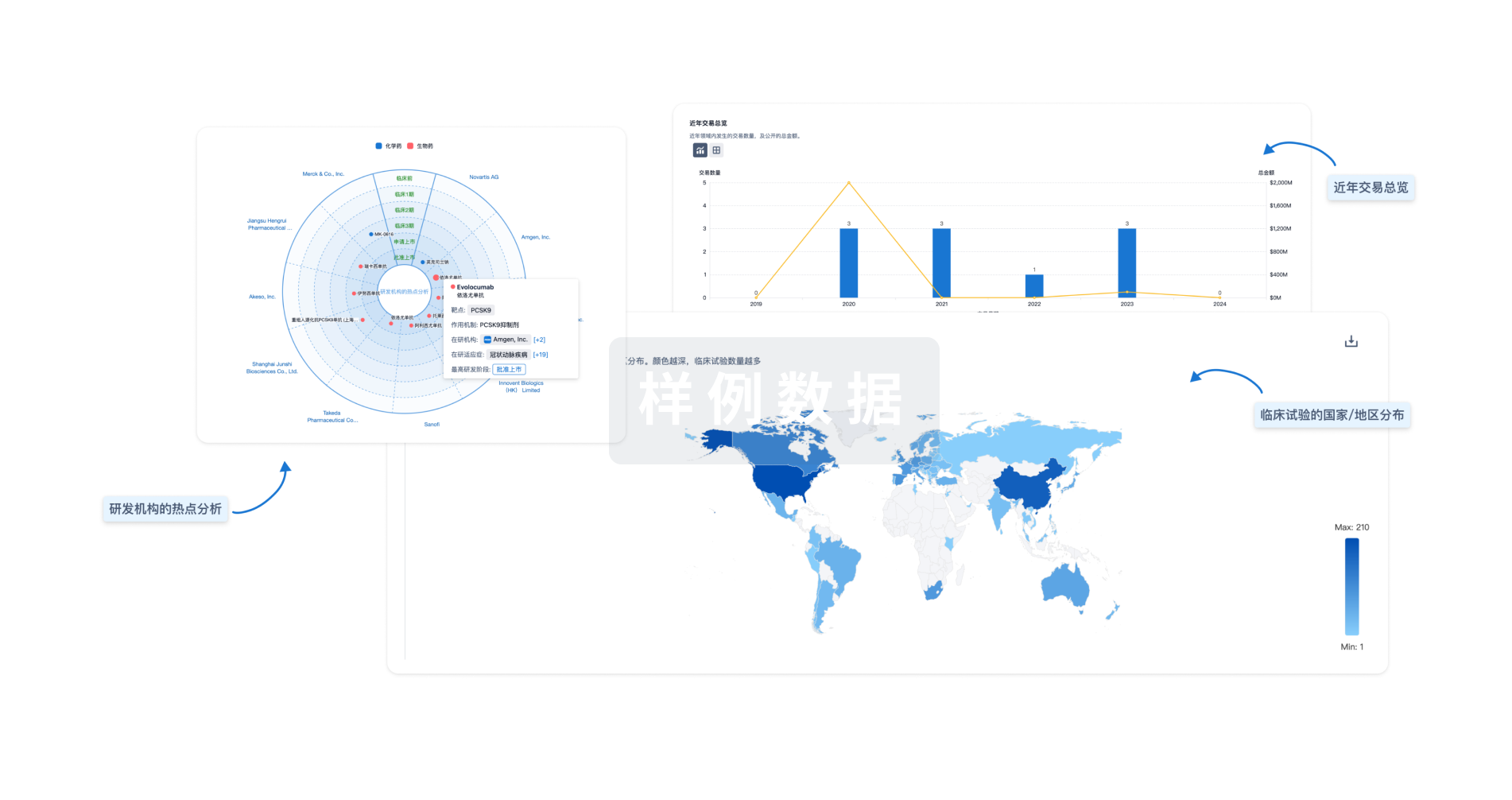预约演示
更新于:2025-05-07
TRPM7
更新于:2025-05-07
基本信息
别名 CHAK1、Channel-kinase 1、Long transient receptor potential channel 7 + [6] |
简介 Bifunctional protein that combines an ion channel with an intrinsic kinase domain, enabling it to modulate cellular functions either by conducting ions through the pore or by phosphorylating downstream proteins via its kinase domain. The channel is highly permeable to divalent cations, specifically calcium (Ca2+), magnesium (Mg2+) and zinc (Zn2+) and mediates their influx (PubMed:11385574, PubMed:12887921, PubMed:15485879, PubMed:24316671, PubMed:35561741, PubMed:36027648). Controls a wide range of biological processes such as Ca2(+), Mg(2+) and Zn(2+) homeostasis, vesicular Zn(2+) release channel and intracellular Ca(2+) signaling, embryonic development, immune responses, cell motility, proliferation and differentiation (By similarity). The C-terminal alpha-kinase domain autophosphorylates cytoplasmic residues of TRPM7 (PubMed:18365021). In vivo, TRPM7 phosphorylates SMAD2, suggesting that TRPM7 kinase may play a role in activating SMAD signaling pathways. In vitro, TRPM7 kinase phosphorylates ANXA1 (annexin A1), myosin II isoforms and a variety of proteins with diverse cellular functions (PubMed:15485879, PubMed:18394644).
The cleaved channel exhibits substantially higher current and potentiates Fas receptor signaling.
The C-terminal kinase domain can be cleaved from the channel segment in a cell-type-specific fashion. In immune cells, the TRPM7 kinase domain is clipped from the channel domain by caspases in response to Fas-receptor stimulation. The cleaved kinase fragments can translocate to the nucleus, and bind chromatin-remodeling complex proteins in a Zn(2+)-dependent manner to ultimately phosphorylate specific Ser/Thr residues of histones known to be functionally important for cell differentiation and embryonic development. |
关联
2
项与 TRPM7 相关的药物靶点 |
作用机制 TRPM7拮抗剂 |
在研机构 |
原研机构 |
非在研适应症- |
最高研发阶段临床前 |
首次获批国家/地区- |
首次获批日期1800-01-20 |
靶点 |
作用机制 TRPM7拮抗剂 |
在研适应症 |
非在研适应症- |
最高研发阶段临床前 |
首次获批国家/地区- |
首次获批日期1800-01-20 |
100 项与 TRPM7 相关的临床结果
登录后查看更多信息
100 项与 TRPM7 相关的转化医学
登录后查看更多信息
0 项与 TRPM7 相关的专利(医药)
登录后查看更多信息
994
项与 TRPM7 相关的文献(医药)2025-06-01·Bioactive Materials
3D-printed PCL scaffolds combined with injectable sodium alginate/magnesium-doped mesoporous bioactive glass nanosphere hydrogel for meniscus regeneration: In vitro, In vivo, and multiomics-based therapeutic analyses
Article
作者: Li, Hao ; Tian, Qinyu ; Zhang, Zhixing ; Zhao, Tianyuan ; Wang, Chao ; Yuan, Zhiguo ; Yang, Yongkang ; Wang, Xue ; Li, Runmeng ; Zhang, Ruiyang ; Guo, Quanyi ; Tang, Peifu ; Gao, Tianze
2025-05-01·Placenta
Placental magnesium transport-related mRNA expression is not associated with serum magnesium in singletons and twins
Article
作者: Park, Clara Yongjoo ; Choi, Myeong Gyun ; Kim, Yoon Ha ; Kim, Jong Woon ; Lee, Cheawon
2025-04-04·Science Advances
Mg
2+
influx mediated by TRPM7 triggers the initiation of muscle stem cell activation
Article
作者: Takabayashi, Shuji ; Tanaka, Kaori ; Ohkawa, Yasuyuki ; Ono, Yusuke ; Kitajima, Yasuo ; Tsuchiya, Masaki ; Sasaki, Mao ; Mori, Yasuo ; Nakabayashi, Chika ; Murakami, Akira ; Matsukawa, Takehisa ; Suzuki, Miki ; Hirano, Kotaro ; Hara, Yuji ; Umemoto, Eiji ; Aoyagi, Yuta ; Matsushita, Masayuki
7
项与 TRPM7 相关的新闻(医药)2023-07-26
·生物谷
阿尔茨海默病是一种神经退行性疾病,其特征是毒性肽淀粉样蛋白-β (Aβ)在脑内的错误沉积、并伴有突触缺失进而产生认知障碍。减少Aβ积累或维持突触密度可以维持阿尔茨海默病患者的正常认知功能。TRPM7是一种独特的离子通道,其C末端包含一个激酶结构域。研究表明TRPM7与神经退行性疾病相关。然而,目前TRPM7是如何参与此类疾病的病理过程仍是未解之谜。近日,复旦大学脑科学研究所那德(Nashat Abumaria)课题组在Science Signaling上发表了一项相关的科学研究。该项研究首先证明了阿尔茨海默病患者和两种阿尔茨海默病模型小鼠的海马组织(参与学习和记忆过程的关键大脑区域)中的TRPM7表达量显著降低。随后,作者发现上调TRPM7或者其激酶结构域的表达量可抵消Aβ的病理毒性。并揭示TRPM7激酶结构域是如何减少脑内Aβ的沉积,并保护突触密度,进而修复阿尔茨海默病模型小鼠的记忆缺陷的(图1)。图1. 研究概述(Aβ:淀粉样蛋白-β;AD:阿尔茨海默病; M7CK:TRPM7的激酶结构域)本研究在阿尔茨海默病患者的脑样本中观察到TRPM7的表达减少后,那德课题组进一步研究发现在两种阿尔茨海默病模型小鼠的海马体中TRPM7的表达量也显著下降。在小鼠海马原代神经元培养中,作者还发现全长的TRPM7或其功能性激酶结构域(M7CK)的过表达阻止了Aβ对突触的毒性。而且,单独过表达TRPM7的离子通道部分或激酶活性被抑制的TRPM7突变体不具有相同的保护作用。TRPM7的功能激酶结构域在不同年龄的阿尔茨海默病的年轻(5-6个月)和老年(14个月)模型小鼠的海马体中过表达可以分别预防和逆转其记忆缺陷。其激酶结构域能够有效修复其脑内突触密度,并减少其海马体中的淀粉样蛋白沉积。在原代神经元培养和小鼠脑中,作者还发现TRPM7的激酶结构域与MMP14(一种参与降解Aβ的金属蛋白酶)相互作用并将其激活。TRPM7的激酶结构域对淀粉样蛋白的沉积的影响是通过其激酶段直接激活蛋白酶MMP14的活性所介导的,并通过MMP14促进其脑内Aβ的降解和清除。这项研究表明,TRPM7在神经退行性疾病病理过程中表达量下降,并揭示了TRPM7通过参与降解Aβ进而影响阿尔茨海默病病理进程的科学机制。这种科学机制可能是阿尔茨海默病领域在基础研究和治疗应用水平上的概念进步。来自复旦大学脑科学研究所那德课题组的博士生张诗萌和曹霏霏是该论文的共同第一作者。来自复旦大学脑科学研究所的那德(Nashat Abumaria)研究员和李薇副研究员是该论文的共同通讯作者。来自中国科学院IRCBC的王文元研究员和陈椰林研究员为本课题提供了5XFAD的模型小鼠。论文链接:https://www-science-org.libproxy1.nus.edu.sg/doi/10.1126/scisignal.ade6325会议推荐1大会信息 会议名称 | 2023第六届单细胞多组学研究与临床应用峰会会议时间 | 2023年9月14-15日会议地点 | 上海虹桥西郊丽笙大酒店大会规模 | 800人主办单位 | 生物谷扫码立即报名
临床结果
2023-04-09
·医药观澜
▎药明康德内容团队编辑PD-1/L1靶点在新药研发上取得了空前的成功,相关的研究不仅斩获了诺贝尔生理学或医学奖,也使得肿瘤的治疗方式发生根本性的改变,而这一切正是靶点发现的结果。创新、有效靶点的开发是驱动疾病疗法产生根本性突破的源头。药明康德内容团队根据疾病类别,整理了今年第一季度发布于国际知名科学期刊上的40项潜在新药靶点,供生物医学产业作为创新研发的参考。限于篇幅,仅针对潜在靶点中的其中数项进行介绍。药明康德内容团队整理靶点:RBFOX2、MPRIP疾病:胰腺癌(PDAC)期刊 / PMID:《自然》/ 36949200发现:PDAC极具侵略性且转移性强,对于造成PDAC转移的驱动基因突变目前仍是未知。在此研究中,研究人员分析了大量原发性和转移性PDAC肿瘤的RNA剪接数据,以识别与PDAC进展相关的差异性剪接事件,并发现与RBFOX2基序高度相似的富集。实验显示,在患者来源的异种移植(PDX)转移性PDAC细胞系中过表达RBFOX2会显著降低这些细胞的体外和体内转移能力,而在原发性胰腺肿瘤细胞系中RBFOX2的耗竭则增加了这些细胞的转移潜力。这些发现显示RBFOX2可能具潜在抑制PDAC转移的作用。RNA测序和剪接分析发现,RBFOX2剪接的靶向基因富集于RHO GTPase途径,显示RBFOX2剪接活性在细胞骨架的组织和成纤维连接的形成中发挥作用。其中RBFOX2调控的肌球蛋白磷酸酶RHO相互作用蛋白(MPRIP)剪接,被证实与PDAC的转移、细胞骨架组织的改变和成纤维连接的诱导相关联。因此通过对RBFOX2选择性剪接事件(例如MPRIP)的精确调节,可能作为PDAC的潜在治疗方式。▲RBFOX2对MPRIP剪接的调节影响胰腺肿瘤细胞的转移能力(图片来源:参考资料[1])靶点:MEN1突变(M327、G331、T349、S160)疾病:Menin抑制剂耐药性期刊 / PMID:《自然》/ 36922589发现:染色质结合蛋白是造血系统细胞状态的重要调节因子。急性白血病是由KMT2A蛋白的重排(KMT2Ar)或核仁蛋白酸核糖体磷酸酰化酶基因(NPM1)的突变所驱动,而这两种变异所导致的异常基因表达则依赖于由MEN1基因编码的menin蛋白维持。Menin抑制剂revumenib能够破坏menin与其配体MLL1之间的相互作用,在一项临床1期试验中显示,带有KMT2Ar或NPM1突变的白血病患者会对revumenib产生应答。通过对menin抑制后产生耐药的患者样本进行分析后发现位于revumenib-menin界面的MEN1基因体细胞突变(M327,G331,T349和S160)。患者的遗传数据、无偏倚碱基编辑器筛选以及在PDX小鼠模型的实验结果皆显示这些突变是一种保守的耐药机制。这些突变体能够在不影响menin与天然配体MLL1相互作用的情形下,干扰revumenib与menin蛋白的结合。这些实验结果显示,针对这些突变体的药物可能是预防或治疗revumenib耐药性的靶点。▲MEN1突变增加癌细胞对revumenib的耐药性(图片来源:参考资料[2])靶点:Smyd3疾病:阿尔茨海默病(AD)期刊 / PMID:Nature Communications/ 36609445发现:许多机制被认为与阿尔茨海默病(AD)有关,包括转录失调、蛋白质修饰异常和突触功能障碍,但这些机制相互如何联系而引发AD中的认知缺陷尚不清楚。此论文发现组蛋白甲基转移酶Smyd3,在AD患者和P301S Tau小鼠(一种tau病理模型)的前额叶皮质(PFC)中显著升高。Smyd3的功能为催化组蛋白H3的赖氨酸4三甲基化(H3K4me3)以激活基因转录。研究人员发现短期使用Smyd3抑制剂BCI-121,能够改善P301S Tau小鼠的认知行为缺陷,并恢复PFC锥体神经元中突触NMDAR的功能和表达。此外,科学家还发现编码E3泛素连接酶以控制NMDAR亚单位降解的Fbxo2蛋白是Smyd3的下游靶标。在PFC中,Fbxo2敲除会导致P301S Tau小鼠NMDAR功能和认知行为的恢复。这些数据显示靶向Smyd3可能是潜在治疗AD的靶点。▲AD中Smyd3升高导致Fbxo2上调,进而导致NMDAR降解与功能减弱,引起认知障碍(图片来源:参考资料[3])靶点:GSDME疾病:动脉粥样硬化期刊 / PMID:Nature Communications/ 36807553发现:细胞焦亡(pyroptosis)的发生可能加重炎症的恶化。为了检视成孔蛋白gasdermin E(GSDME)介导的细胞焦亡是否加剧动脉粥样硬化进程,研究人员制造了ApoE和GSDME双基因缺陷小鼠,并发现相较于对照小鼠,GSDME-/-/ApoE-/-小鼠在高脂饮食刺激下显示出较少动脉粥样硬化病变的面积和炎症反应。单细胞转录组分析发现GSDME主要表达于巨噬细胞。在体外实验中,氧化低密度脂蛋白(ox-LDL)可刺激巨噬细胞中GSDME的表达和细胞焦亡增加。机制上,在巨噬细胞删除GSDME抑制了ox-LDL诱导的炎症和巨噬细胞发生细胞焦亡。此外,信号转导和转录激活因子3(STAT3)直接与GSDME表达呈正相关,且正调控GSDME的表达。此研究显示GSDME在动脉粥样硬化发展中所参与的转录机制,靶向GSDME可能是抑制动脉粥样硬化进程的潜在疗法。▲GSDME缺乏降低动脉粥样硬化病变面积和大小(图片来源:参考资料[4])靶点:DDX5疾病:肠道炎症疾病期刊 / PMID:Science Advances/ 36724232发现:表达视黄醇相关孤儿受体(RAR)γt(RORγt)的调节性T细胞(RORγt+ Treg)在防止T细胞过度激活和维持组织稳态方面发挥重要作用,这部分是通过其所分泌的抗炎细胞因子白介素-10(IL-10)所达成。研究人员发现缺氧诱导因子1α(HIF1α)是RORγt+ Treg细胞内的主要转录因子。RNA结合蛋白DEAD盒螺旋酶5(DDX5)则主要对此抗炎途径进行负调节。作为转录共抑制剂,DDX5限制了RORγt+ Treg细胞中HIF1α及其下游靶基因IL-10的表达。T细胞特异性的Ddx5基因敲除(DDX5ΔT)小鼠具有增强的RORγt+ Treg活性,并且对肠炎具有更好的保护作用。而遗传性消除或通过药物抑制HIF1α则恢复DDX5ΔT小鼠罹患炎症肠病的倾向。值得一提的是,科学家证实DDX5-HIF1α-IL-10通路在小鼠和人类当中是一致的,显示DDX5为肠道炎症性疾病的潜在治疗靶点。▲T细胞中的DDX5促进肠道炎症(图片来源:参考资料[5])靶点:NTRK3-NT3通路疾病:非酒精性脂肪性肝炎(NASH)期刊 / PMID:Science Translational Medicine/ 36599008发现:由肝星状细胞(HSC)活化驱动的晚期肝纤维化是预测非酒精性脂肪性肝炎(NASH)患者死亡的强烈预测因子。然而,至今尚无获批的抗纤维化疗法。为了识别抗纤维化药物靶点,通过单细胞核RNA测序(single-nucleus RNAseq)和组织清除技术,研究人员在NASH小鼠模型中整合了伴随HSC活化的渐进性转录组和形态学反应。研究人员在晚期纤维化中发现一个由68种受体-配体相互作用构成的自分泌HSC信号通路,此通路在小鼠和人类NASH中具保守性。当以药物抑制神经营养因子受体酪氨酸激酶3(NTRK3)-神经营养因子3(NT3)自分泌相互作用时发现,人类体外HSC的活化受抑制,并逆转晚期NASH小鼠的纤维化。这些数据显示,阶段特定性的治疗可能加强晚期肝纤维化患者的抗纤维化治疗,且抑制NTRK3-NT3通路为潜在抗NASH纤维化靶点。▲论文登上当期Science Translational Medicine杂志封面(图片来源:参考资料[6])靶点:TRPM7疾病:肥胖期刊 / PMID:Nature Communications/ 36717580发现:白色脂肪组织中的慢性炎症是联结肥胖以及与之相关代谢综合症的关键。瞬时受体电位离子通道TRPM7已知与炎症有关,但TRPM7在肥胖患者的脂肪细胞表型和功能中的作用仍是未知。研究人员发现,脂肪细胞内TRPM7的激活在促炎性反应中发挥了重要作用。在高脂饮食喂养的成年雄性小鼠身上,脂肪细胞TRPM7的缺乏减缓小鼠的促炎性表型、改善其葡萄糖稳态,并抑制体重增加。机制上,TRPM7的促炎作用取决于钙离子信号。通过钙/钙调蛋白依赖性蛋白激酶II(CaMKⅡ)和肿瘤坏死因子受体相关因子6(TRAF6)的共同调节,TRPM7所引发的钙离子内流能够增强转化生长因子-β活化激酶1(TAK1)的活化,从而导致核因子κB(NF-κB)信号的增强。重要的是,TRPM7抑制剂的使用可保护肥胖小鼠免受肥胖和胰岛素抵抗的影响。这些实验结果显示,TRPM7是调节肥胖中脂肪组织炎症发展的因素,且能够调节胰岛素敏感性,是治疗肥胖患者的潜在靶点。▲脂肪细胞TRPM7的缺乏降低高脂饮食诱导的肥胖(图片来源:参考资料[7])限于篇幅,仅针对潜在靶点中的其中数项进行介绍。期待这些创新研究能够带来真正的临床医学转化,造福不同疾病的患者。参考资料:(可上下滑动查看) [1] Jbara, Amina et al. “RBFOX2 modulates a metastatic signature of alternative splicing in pancreatic cancer.” Nature, 10.1038/s41586-023-05820-3. 22 Mar. 2023, doi:10.1038/s41586-023-05820-3[2] Perner, Florian et al. “MEN1 mutations mediate clinical resistance to menin inhibition.” Nature vol. 615,7954 (2023): 913-919. doi:10.1038/s41586-023-05755-9[3] Williams, Jamal B et al. “Inhibition of histone methyltransferase Smyd3 rescues NMDAR and cognitive deficits in a tauopathy mouse model.” Nature communications vol. 14,1 91. 6 Jan. 2023, doi:10.1038/s41467-022-35749-6[4] Wei, Yuanyuan et al. “GSDME-mediated pyroptosis promotes the progression and associated inflammation of atherosclerosis.” Nature communications vol. 14,1 929. 18 Feb. 2023, doi:10.1038/s41467-023-36614-w[5] Ma, Shengyun et al. “RNA binding protein DDX5 restricts RORγt+ Treg suppressor function to promote intestine inflammation.” Science advances vol. 9,5 (2023): eadd6165. doi:10.1126/sciadv.add6165[6] SCIENCE TRANSLATIONAL MEDICINE. Retrieved April 4, 2023 from https://www-science-org.libproxy1.nus.edu.sg/toc/stm/15/677[7] Zhong, Weiting et al. “Adipose-specific deletion of the cation channel TRPM7 inhibits TAK1 kinase-dependent inflammation and obesity in male mice.” Nature communications vol. 14,1 491. 30 Jan. 2023, doi:10.1038/s41467-023-36154-3本文来自药明康德内容团队,欢迎个人转发至朋友圈,谢绝媒体或机构未经授权以任何形式转载至其他平台。转载授权请在「药明康德」微信公众号留言联系我们。其他合作需求,请联系wuxi_media@wuxiapptec.com。免责声明:药明康德内容团队专注介绍全球生物医药健康研究进展。本文仅作信息交流之目的,文中观点不代表药明康德立场,亦不代表药明康德支持或反对文中观点。本文也不是治疗方案推荐。如需获得治疗方案指导,请前往正规医院就诊。
临床1期
2023-04-07
·药明康德
▎药明康德内容团队编辑PD-1/L1靶点在新药研发上取得了空前的成功,相关的研究不仅斩获了诺贝尔生理学或医学奖,也使得肿瘤的治疗方式发生根本性的改变,而这一切正是靶点发现的结果。创新、有效靶点的开发是驱动疾病疗法产生根本性突破的源头。药明康德内容团队根据疾病类别,整理了今年第一季度发布于国际知名科学期刊上的40项潜在新药靶点,供生物医学产业作为创新研发的参考。限于篇幅,仅针对潜在靶点中的其中数项进行介绍。药明康德内容团队整理靶点:RBFOX2、MPRIP疾病:胰腺癌(PDAC)期刊 / PMID:《自然》/ 36949200发现:PDAC极具侵略性且转移性强,对于造成PDAC转移的驱动基因突变目前仍是未知。在此研究中,研究人员分析了大量原发性和转移性PDAC肿瘤的RNA剪接数据,以识别与PDAC进展相关的差异性剪接事件,并发现与RBFOX2基序高度相似的富集。实验显示,在患者来源的异种移植(PDX)转移性PDAC细胞系中过表达RBFOX2会显著降低这些细胞的体外和体内转移能力,而在原发性胰腺肿瘤细胞系中RBFOX2的耗竭则增加了这些细胞的转移潜力。这些发现显示RBFOX2可能具潜在抑制PDAC转移的作用。RNA测序和剪接分析发现,RBFOX2剪接的靶向基因富集于RHO GTPase途径,显示RBFOX2剪接活性在细胞骨架的组织和成纤维连接的形成中发挥作用。其中RBFOX2调控的肌球蛋白磷酸酶RHO相互作用蛋白(MPRIP)剪接,被证实与PDAC的转移、细胞骨架组织的改变和成纤维连接的诱导相关联。因此通过对RBFOX2选择性剪接事件(例如MPRIP)的精确调节,可能作为PDAC的潜在治疗方式。▲RBFOX2对MPRIP剪接的调节影响胰腺肿瘤细胞的转移能力(图片来源:参考资料[1])靶点:MEN1突变(M327、G331、T349、S160)疾病:Menin抑制剂耐药性期刊 / PMID:《自然》/ 36922589发现:染色质结合蛋白是造血系统细胞状态的重要调节因子。急性白血病是由KMT2A蛋白的重排(KMT2Ar)或核仁蛋白酸核糖体磷酸酰化酶基因(NPM1)的突变所驱动,而这两种变异所导致的异常基因表达则依赖于由MEN1基因编码的menin蛋白维持。Menin抑制剂revumenib能够破坏menin与其配体MLL1之间的相互作用,在一项临床1期试验中显示,带有KMT2Ar或NPM1突变的白血病患者会对revumenib产生应答。通过对menin抑制后产生耐药的患者样本进行分析后发现位于revumenib-menin界面的MEN1基因体细胞突变(M327,G331,T349和S160)。患者的遗传数据、无偏倚碱基编辑器筛选以及在PDX小鼠模型的实验结果皆显示这些突变是一种保守的耐药机制。这些突变体能够在不影响menin与天然配体MLL1相互作用的情形下,干扰revumenib与menin蛋白的结合。这些实验结果显示,针对这些突变体的药物可能是预防或治疗revumenib耐药性的靶点。▲MEN1突变增加癌细胞对revumenib的耐药性(图片来源:参考资料[2])靶点:Smyd3疾病:阿尔茨海默病(AD)期刊 / PMID:Nature Communications/ 36609445发现:许多机制被认为与阿尔茨海默病(AD)有关,包括转录失调、蛋白质修饰异常和突触功能障碍,但这些机制相互如何联系而引发AD中的认知缺陷尚不清楚。此论文发现组蛋白甲基转移酶Smyd3,在AD患者和P301S Tau小鼠(一种tau病理模型)的前额叶皮质(PFC)中显著升高。Smyd3的功能为催化组蛋白H3的赖氨酸4三甲基化(H3K4me3)以激活基因转录。研究人员发现短期使用Smyd3抑制剂BCI-121,能够改善P301S Tau小鼠的认知行为缺陷,并恢复PFC锥体神经元中突触NMDAR的功能和表达。此外,科学家还发现编码E3泛素连接酶以控制NMDAR亚单位降解的Fbxo2蛋白是Smyd3的下游靶标。在PFC中,Fbxo2敲除会导致P301S Tau小鼠NMDAR功能和认知行为的恢复。这些数据显示靶向Smyd3可能是潜在治疗AD的靶点。▲AD中Smyd3升高导致Fbxo2上调,进而导致NMDAR降解与功能减弱,引起认知障碍(图片来源:参考资料[3])靶点:GSDME疾病:动脉粥样硬化期刊 / PMID:Nature Communications/ 36807553发现:细胞焦亡(pyroptosis)的发生可能加重炎症的恶化。为了检视成孔蛋白gasdermin E(GSDME)介导的细胞焦亡是否加剧动脉粥样硬化进程,研究人员制造了ApoE和GSDME双基因缺陷小鼠,并发现相较于对照小鼠,GSDME-/-/ApoE-/-小鼠在高脂饮食刺激下显示出较少动脉粥样硬化病变的面积和炎症反应。单细胞转录组分析发现GSDME主要表达于巨噬细胞。在体外实验中,氧化低密度脂蛋白(ox-LDL)可刺激巨噬细胞中GSDME的表达和细胞焦亡增加。机制上,在巨噬细胞删除GSDME抑制了ox-LDL诱导的炎症和巨噬细胞发生细胞焦亡。此外,信号转导和转录激活因子3(STAT3)直接与GSDME表达呈正相关,且正调控GSDME的表达。此研究显示GSDME在动脉粥样硬化发展中所参与的转录机制,靶向GSDME可能是抑制动脉粥样硬化进程的潜在疗法。▲GSDME缺乏降低动脉粥样硬化病变面积和大小(图片来源:参考资料[4])靶点:DDX5疾病:肠道炎症疾病期刊 / PMID:Science Advances/ 36724232发现:表达视黄醇相关孤儿受体(RAR)γt(RORγt)的调节性T细胞(RORγt+ Treg)在防止T细胞过度激活和维持组织稳态方面发挥重要作用,这部分是通过其所分泌的抗炎细胞因子白介素-10(IL-10)所达成。研究人员发现缺氧诱导因子1α(HIF1α)是RORγt+ Treg细胞内的主要转录因子。RNA结合蛋白DEAD盒螺旋酶5(DDX5)则主要对此抗炎途径进行负调节。作为转录共抑制剂,DDX5限制了RORγt+ Treg细胞中HIF1α及其下游靶基因IL-10的表达。T细胞特异性的Ddx5基因敲除(DDX5ΔT)小鼠具有增强的RORγt+ Treg活性,并且对肠炎具有更好的保护作用。而遗传性消除或通过药物抑制HIF1α则恢复DDX5ΔT小鼠罹患炎症肠病的倾向。值得一提的是,科学家证实DDX5-HIF1α-IL-10通路在小鼠和人类当中是一致的,显示DDX5为肠道炎症性疾病的潜在治疗靶点。▲T细胞中的DDX5促进肠道炎症(图片来源:参考资料[5])靶点:NTRK3-NT3通路疾病:非酒精性脂肪性肝炎(NASH)期刊 / PMID:Science Translational Medicine/ 36599008发现:由肝星状细胞(HSC)活化驱动的晚期肝纤维化是预测非酒精性脂肪性肝炎(NASH)患者死亡的强烈预测因子。然而,至今尚无获批的抗纤维化疗法。为了识别抗纤维化药物靶点,通过单细胞核RNA测序(single-nucleus RNAseq)和组织清除技术,研究人员在NASH小鼠模型中整合了伴随HSC活化的渐进性转录组和形态学反应。研究人员在晚期纤维化中发现一个由68种受体-配体相互作用构成的自分泌HSC信号通路,此通路在小鼠和人类NASH中具保守性。当以药物抑制神经营养因子受体酪氨酸激酶3(NTRK3)-神经营养因子3(NT3)自分泌相互作用时发现,人类体外HSC的活化受抑制,并逆转晚期NASH小鼠的纤维化。这些数据显示,阶段特定性的治疗可能加强晚期肝纤维化患者的抗纤维化治疗,且抑制NTRK3-NT3通路为潜在抗NASH纤维化靶点。▲论文登上当期Science Translational Medicine杂志封面(图片来源:参考资料[6])靶点:TRPM7疾病:肥胖期刊 / PMID:Nature Communications/ 36717580发现:白色脂肪组织中的慢性炎症是联结肥胖以及与之相关代谢综合症的关键。瞬时受体电位离子通道TRPM7已知与炎症有关,但TRPM7在肥胖患者的脂肪细胞表型和功能中的作用仍是未知。研究人员发现,脂肪细胞内TRPM7的激活在促炎性反应中发挥了重要作用。在高脂饮食喂养的成年雄性小鼠身上,脂肪细胞TRPM7的缺乏减缓小鼠的促炎性表型、改善其葡萄糖稳态,并抑制体重增加。机制上,TRPM7的促炎作用取决于钙离子信号。通过钙/钙调蛋白依赖性蛋白激酶II(CaMKⅡ)和肿瘤坏死因子受体相关因子6(TRAF6)的共同调节,TRPM7所引发的钙离子内流能够增强转化生长因子-β活化激酶1(TAK1)的活化,从而导致核因子κB(NF-κB)信号的增强。重要的是,TRPM7抑制剂的使用可保护肥胖小鼠免受肥胖和胰岛素抵抗的影响。这些实验结果显示,TRPM7是调节肥胖中脂肪组织炎症发展的因素,且能够调节胰岛素敏感性,是治疗肥胖患者的潜在靶点。▲脂肪细胞TRPM7的缺乏降低高脂饮食诱导的肥胖(图片来源:参考资料[7])限于篇幅,仅针对潜在靶点中的其中数项进行介绍。期待这些创新研究能够带来真正的临床医学转化,造福不同疾病的患者。药明康德为全球生物医药行业提供一体化、端到端的新药研发和生产服务,服务范围涵盖化学药研发和生产、生物学研究、临床前测试和临床试验研发、细胞及基因疗法研发、测试和生产等领域。如您有相关业务需求,欢迎点击下方图片填写具体信息。▲如您有任何业务需求,请长按扫描上方二维码,或点击文末“阅读原文/Read more”,即可访问业务对接平台,填写业务需求信息▲欲了解更多前沿技术在生物医药产业中的应用,请长按扫描上方二维码,即可访问“药明直播间”,观看相关话题的直播讨论与精彩回放*药明康德统计于2023年1月至3月底,发布于《自然》、《科学》、《细胞》、Cancer Cell、Nature Cancer、Nature Communications、Science Translational Medicine、Science Advances等众知名期刊,具有哺乳动物实验支持,具研究新颖性,且尚未进入临床2期(或以上)试验的创新靶点。若不符合筛选标准的潜在靶点则未纳入统计之中。参考资料:[1] Jbara, Amina et al. “RBFOX2 modulates a metastatic signature of alternative splicing in pancreatic cancer.” Nature, 10.1038/s41586-023-05820-3. 22 Mar. 2023, doi:10.1038/s41586-023-05820-3[2] Perner, Florian et al. “MEN1 mutations mediate clinical resistance to menin inhibition.” Nature vol. 615,7954 (2023): 913-919. doi:10.1038/s41586-023-05755-9[3] Williams, Jamal B et al. “Inhibition of histone methyltransferase Smyd3 rescues NMDAR and cognitive deficits in a tauopathy mouse model.” Nature communications vol. 14,1 91. 6 Jan. 2023, doi:10.1038/s41467-022-35749-6[4] Wei, Yuanyuan et al. “GSDME-mediated pyroptosis promotes the progression and associated inflammation of atherosclerosis.” Nature communications vol. 14,1 929. 18 Feb. 2023, doi:10.1038/s41467-023-36614-w[5] Ma, Shengyun et al. “RNA binding protein DDX5 restricts RORγt+ Treg suppressor function to promote intestine inflammation.” Science advances vol. 9,5 (2023): eadd6165. doi:10.1126/sciadv.add6165[6] SCIENCE TRANSLATIONAL MEDICINE. Retrieved April 4, 2023 from https://www-science-org.libproxy1.nus.edu.sg/toc/stm/15/677[7] Zhong, Weiting et al. “Adipose-specific deletion of the cation channel TRPM7 inhibits TAK1 kinase-dependent inflammation and obesity in male mice.” Nature communications vol. 14,1 491. 30 Jan. 2023, doi:10.1038/s41467-023-36154-3免责声明:药明康德内容团队专注介绍全球生物医药健康研究进展。本文仅作信息交流之目的,文中观点不代表药明康德立场,亦不代表药明康德支持或反对文中观点。本文也不是治疗方案推荐。如需获得治疗方案指导,请前往正规医院就诊。版权说明:本文来自药明康德内容团队,欢迎个人转发至朋友圈,谢绝媒体或机构未经授权以任何形式转载至其他平台。转载授权请在「药明康德」微信公众号回复“转载”,获取转载须知。分享,点赞,在看,聚焦全球生物医药健康创新
临床1期
分析
对领域进行一次全面的分析。
登录
或

生物医药百科问答
全新生物医药AI Agent 覆盖科研全链路,让突破性发现快人一步
立即开始免费试用!
智慧芽新药情报库是智慧芽专为生命科学人士构建的基于AI的创新药情报平台,助您全方位提升您的研发与决策效率。
立即开始数据试用!
智慧芽新药库数据也通过智慧芽数据服务平台,以API或者数据包形式对外开放,助您更加充分利用智慧芽新药情报信息。
生物序列数据库
生物药研发创新
免费使用
化学结构数据库
小分子化药研发创新
免费使用

